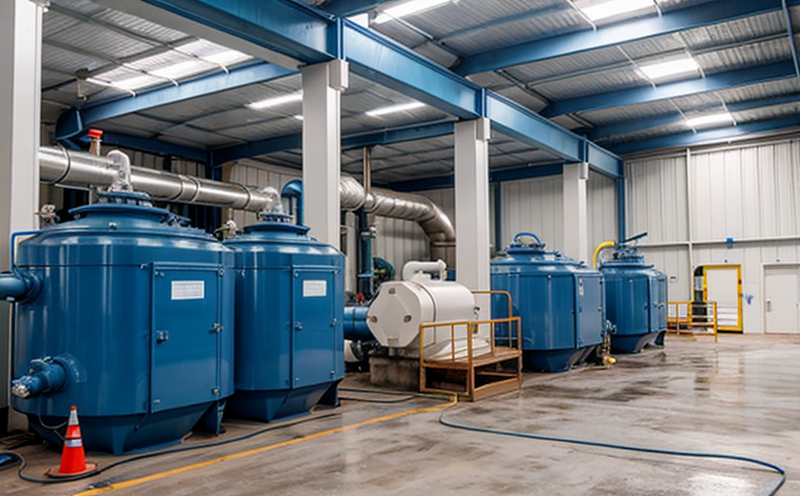ASTM D5462 Chlorination Testing of Ballast Water
The ASTM D5462 standard provides a method for determining the chlorine concentration in ballast water used in the maritime industry. This service is crucial for ensuring that ships comply with international regulations aimed at preventing the introduction and spread of harmful aquatic organisms through ballast water exchange.
Chlorination is one of the most commonly employed methods to disinfect ballast water, killing or deactivating potential pathogens and invasive species before the water is discharged into new waters. The effectiveness of this method can be quantified by measuring the residual chlorine levels in the water after treatment. This test ensures that the discharge does not pose a risk to local ecosystems.
The ASTM D5462 method involves several key steps, including sampling the ballast water, preparing it for analysis, and then measuring the chlorine concentration using a suitable analytical technique such as iodometric titration or photometric methods. The standard specifies detailed procedures to ensure that the results are accurate and reliable.
Accurate measurement of residual chlorine is essential not only for regulatory compliance but also for optimizing treatment processes. By knowing the exact amount of chlorine present, operators can adjust dosages to achieve optimal disinfection without over-chlorinating the water, which could harm beneficial organisms or cause other environmental issues.
The testing process begins with proper sampling techniques that ensure a representative sample is taken from the ballast water tanks. Once collected, the sample undergoes preparation steps such as filtration and dilution if necessary, to bring it within the appropriate concentration range for analysis. The actual measurement of residual chlorine typically involves titration or using a photometer calibrated according to ASTM D5462.
The standard also provides guidance on acceptable limits for residual chlorine in ballast water discharge, which vary depending on the specific regulations applicable to the shipping route and port of call. Compliance with these standards is critical to avoid penalties and ensure sustainable maritime practices.
For quality managers, compliance officers, R&D engineers, and procurement personnel involved in ship operations, understanding ASTM D5462 is essential for ensuring that all ballast water treatment systems meet the necessary performance criteria. By adhering to this standard, operators can demonstrate their commitment to environmental stewardship and regulatory compliance.
The significance of ASTM D5462 extends beyond just meeting legal requirements; it plays a vital role in maintaining the integrity of marine ecosystems worldwide. The method helps prevent the introduction of non-native species into new environments, which can disrupt local biodiversity and ecosystem balance. By employing this testing protocol, mariners contribute to global efforts aimed at preserving ocean health.
Applied Standards
The ASTM D5462 standard is widely recognized for its reliability in measuring chlorine concentration in ballast water. This standard has been adopted by numerous international regulatory bodies and is considered the gold standard for this type of testing. Some key aspects of the standard include:
- Sampling procedures
- Sample preparation guidelines
- Analytical methods for determining residual chlorine
- Absolute precision requirements
- Acceptance criteria
The standard is updated periodically to reflect advancements in technology and changing regulatory landscapes. Compliance with ASTM D5462 ensures that testing results are consistent, reproducible, and comparable across different laboratories and regions.
Industry Applications
| Application | Description |
|---|---|
| Regulatory Compliance | To ensure compliance with international regulations such as the International Maritime Organization (IMO) Ballast Water Management Convention. |
| Optimized Treatment Processes | To achieve optimal disinfection without over-chlorination, which could harm beneficial organisms or cause other environmental issues. |
| Ecosystem Preservation | To prevent the introduction of non-native species into new environments and disrupt local biodiversity and ecosystem balance. |
| Quality Assurance | To provide consistent and reliable data for decision-making in ship operations and maintenance. |
The ASTM D5462 method is not only crucial for compliance but also serves as a tool for continuous improvement in ballast water treatment systems. By regularly monitoring residual chlorine levels, operators can identify areas where improvements are needed and implement necessary adjustments to enhance the effectiveness of their treatment processes.
- Ensures that ships adhere to international regulations aimed at preventing the introduction and spread of harmful aquatic organisms through ballast water exchange.
- Optimizes treatment processes by providing accurate data on chlorine concentration, enabling operators to adjust dosages appropriately.
- Promotes ecosystem preservation by minimizing the risk of introducing non-native species into new environments.
- Serves as a quality assurance measure for ship operations and maintenance, ensuring consistent and reliable test results.
Eurolab Advantages
At Eurolab, we pride ourselves on providing comprehensive testing services that meet the highest industry standards. Our expertise in ASTM D5462 chlorination testing of ballast water includes:
- State-of-the-art laboratory facilities equipped with advanced analytical instruments.
- A team of highly qualified and experienced professionals specializing in marine and ship equipment testing.
- Comprehensive quality control measures to ensure the accuracy and reliability of all test results.
- Expertise in interpreting ASTM D5462 standards and providing actionable insights for operators.
We understand that compliance with international regulations is critical for the maritime industry. By leveraging our extensive experience and cutting-edge technology, we offer a seamless testing process tailored to meet your specific needs. Our services are designed to help you stay compliant while optimizing treatment processes and preserving marine ecosystems.





